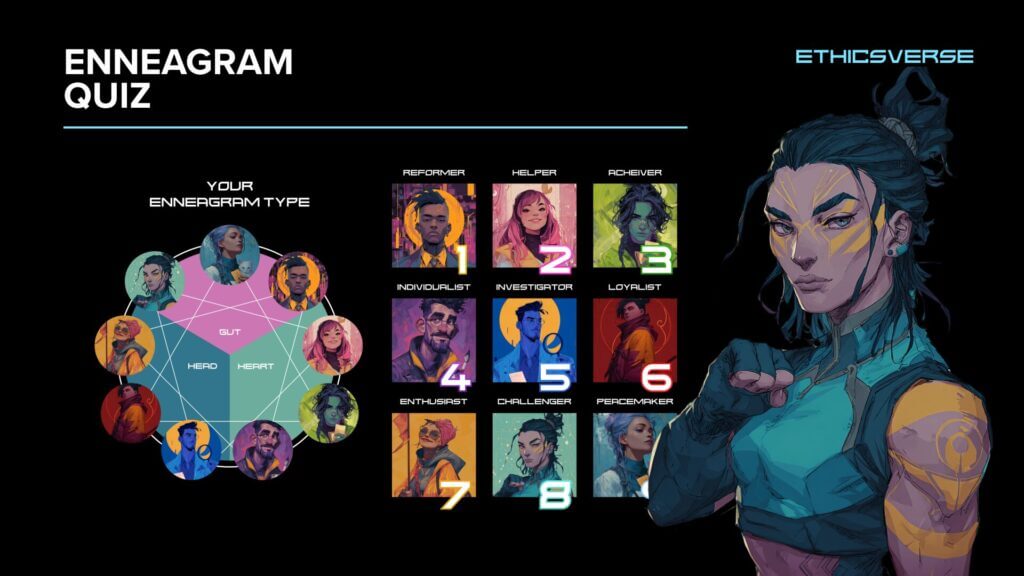How The Enneagram Can Make You A Better Compliance Professional


Full Episode Available
WATCH ON-DEMANDFind Your Enneagram Type
TAKE OUR QUIZThis episode of The Ethicsverse examines the strategic application of the Enneagram personality framework within ethics and compliance functions, positioning it as a behavioral intelligence tool for enhancing professional effectiveness. Unlike assessment instruments that categorize observable traits, the Enneagram identifies nine distinct personality types differentiated by core motivations, fears, desires, and coping mechanisms—psychological drivers that fundamentally shape how individuals perceive risk, process information, respond to authority, and navigate ethical dilemmas. By developing fluency in recognizing these patterns, compliance professionals can allocate resources more strategically, communicate more persuasively across organizational levels, build psychologically safer speak-up cultures, and design interventions that account for the full spectrum of human motivation—ultimately repositioning compliance from rule enforcement to behavioral architecture that serves diverse stakeholder needs.
Featuring:
- Melanie Sponholz, Deputy Compliance Officer, BAYADA Home Health Care
- Gwen Lee Hassan, Vice President and Chief Compliance Officer, Unisys
- Nick Gallo, Chief Servant & Co-CEO, Ethico
Key Takeaways
Understanding Core Motivations Reveals Hidden Behavioral Drivers
- The Enneagram differs from other personality assessments by focusing on core motivations, fears, desires, and longings rather than observable behaviors, providing insight into why people act rather than just how they act.
- Each of the nine types operates from a distinct psychological worldview:
- Type 1 seeks correctness and integrity
- Type 2 craves being needed and appreciated
- Type 3 pursues success and admiration
- Type 4 desires uniqueness and authenticity
- Type 5 gathers knowledge for protection
- Type 6 seeks security and preparedness
- Type 7 chases happiness and possibility
- Type 8 protects through strength and control
- Type 9 prioritizes harmony and peace.
- Only individuals can accurately type themselves because external behaviors may mask underlying motivations—a three and a two might both work hard, but the three seeks achievement while the two seeks to be valued for helping others.
Self-Awareness Transforms Professional Effectiveness
- Learning your Enneagram type reveals default patterns, blind spots, and stress responses that unconsciously shape your compliance approach, allowing you to move from reactive to intentional behavior.
- Each type has characteristic strengths to lean into (Type 1 attention to detail, Type 3 goal orientation, Type 6 risk identification) and predictable weaknesses to monitor (Type 1 black-and-white thinking, Type 3 compartmentalized emotions, Type 6 analysis paralysis).
- Recognizing your disintegration pattern—where you move under stress—serves as an early warning system for burnout.
The Three Intelligence Centers Shape Decision-Making Styles
- The gut center (Types 8, 9, 1) processes through instinct and action, expressing anger-based emotions and making decisions from a body-centered, justice-oriented perspective.
- The heart center (Types 2, 3, 4) operates through emotional attunement and image-consciousness, with Type 2 externalizing feelings toward others, Type 4 internalizing all emotional energy, and Type 3 compartmentalizing feelings to maintain forward momentum.
- The head center (Types 5, 6, 7) thinks and plans from a fear-based security orientation, prioritizing information gathering, risk assessment, and future scenario planning in their approach to problems.
Adapting Communication Styles Increases Influence
- Each type has a characteristic speaking style—Type 1 preaches about the right way, Type 2 apologizes while helping, Type 3 pitches persuasively, Type 4 expresses emotional depth, Type 5 lectures with comprehensive detail, Type 6 warns about risks, Type 7 tells exciting stories, Type 8 commands with directness, and Type 9 seeks everyone’s perspective before deciding.
- Effective compliance communication layers messages to resonate across types simultaneously—emphasizing integrity for ones, appreciation for twos, achievement for threes, security for sixes, and harmony for nines in the same policy rollout or training.
- Understanding your manager’s type allows strategic adaptation of deliverables—leading with bottom-line recommendations for Type 3 and Type 8 leaders while providing comprehensive research upfront for Type 5 leaders who need to see the analytical foundation.
Policy Development Requires Multi-Type Accessibility
- Type 1 professionals excel at developing clear, correct procedures without cutting corners, ensuring policies reflect the right standards and regulatory requirements.
- Type 5 team members provide comprehensive logical analysis and research depth that grounds policies in thorough data review and consideration of complex scenarios.
- Type 9 contributions ensure policies promote organizational harmony and avoid unnecessary conflict, making compliance frameworks feel inclusive rather than punitive.
Training Design Must Appeal to Diverse Motivational Profiles
- Effective compliance training includes varied appeal points—”it’s the right thing to do” resonates with Type 1, “we need your help” engages Type 2, “it achieves strategic objectives” motivates Type 3, and “we’ve prepared for contingencies” reassures Type 6.
- Microlearning formats should include optional deep-dive resources for Type 5 learners who feel unsatisfied without comprehensive details, while keeping core content accessible for Type 7 learners who prefer engaging, fast-paced delivery.
- Training presenters with Type 7 energy bring dynamic enthusiasm and storytelling that maintains engagement, while Type 1 presenters ensure accuracy and thoroughness in covering compliance requirements.
Investigation Approaches Benefit from Type-Aware Interviewing
- Interview techniques should flex based on subject personality—using directness with Type 8 individuals even if that’s not your natural style, allowing emotional processing time for Type 4 subjects, and providing reassuring structure for Type 6 witnesses.
- Type 5 team members excel at root cause analysis, deep-dive investigations, and synthesizing complex data patterns across multiple cases to identify systemic issues.
- Maintaining investigation consistency and objectivity is essential, but adaptation in communication approach based on personality type yields more complete information gathering without compromising impartiality.
Risk Assessment Leverages Complementary Type Strengths
- Type 6 professionals are invaluable for risk identification because their natural worst-case-scenario thinking, skepticism, and ability to spot potential problems makes them see around corners that other types miss.
- Type 8 team members provide the decisive action orientation needed to address identified risks quickly and assertively, while Type 3 and Type 5 members contribute data analysis and strategic implementation planning.
- Comprehensive risk assessment benefits from diverse type representation on the team—if building with limited resources, prioritize Type 6 for risk identification capability, then supplement with action-oriented and analytical types.
Stakeholder Engagement Succeeds Through Tailored Delivery
- Executive stakeholders respond to risk communications through their type lens—Type 2 leaders want recognition of team effort, Type 3 executives seek measurable progress metrics, and Type 9 board members prioritize balanced organizational harmony.
- Building trust varies by type—betraying a Type 8 destroys the relationship permanently, while taking a Type 2 for granted or failing to express appreciation severely damages rapport.
- Identifying key stakeholder types allows strategic customization of presentations, reports, and requests that align with their core motivations, significantly increasing buy-in and support for compliance initiatives.
Ethical Culture Building Requires Type-Aware Leadership
- Type-specific blind spots can create ethical vulnerabilities—Type 3 fear of failure may drive corner-cutting to achieve goals, Type 2 people-pleasing can compromise enforcement boundaries, and Type 9 conflict avoidance delays necessary accountability conversations.
- Building sustainable integrity culture means painting the value proposition in colors all types see—ethical behavior supports doing right (Type 1), helps stakeholders (Type 2), achieves objectives (Type 3), protects the organization (Type 6), and creates harmony (Type 9).
- Empowering team members means assigning work that feeds their natural strengths while providing support in blind-spot areas—giving detailed analysis to Type 5, high-stakes negotiations to Type 8, and consensus-building facilitation to Type 9.
Conclusion
The Enneagram offers compliance professionals far more than personality categorization—it provides a practical diagnostic framework for understanding the core motivations, fears, and communication patterns that drive human behavior in organizational settings. By developing fluency in recognizing these nine distinct approaches to risk, integrity, and decision-making, compliance teams can design more effective policies, deliver more resonant training, conduct more productive investigations, and build stronger stakeholder relationships. The key insight is that effectiveness in ethics and compliance fundamentally depends on human connection and behavioral influence, which requires moving beyond one-size-fits-all approaches to embrace the beautiful diversity of how different people process information, respond to pressure, and make ethical choices. This framework invites practitioners to cultivate genuine curiosity about themselves and others, using type awareness not as a limiting label but as a lens for strategic empowerment that positions compliance as human-centered behavioral architecture rather than rule enforcement.





































